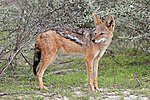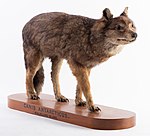| Canini | |
|---|---|

| |
| Canina (represented by the golden jackal) and Cerdocyonina (represented by the crab-eating fox) | |
|
Scientific classification
| |
| Domain: | Eukaryota |
| Kingdom: | Animalia |
| Phylum: | Chordata |
| Class: | Mammalia |
| Order: | Carnivora |
| Family: | Canidae |
| Subfamily: | Caninae |
| Tribe: |
Canini Fischer de Waldheim, 1817 [2] |
| Genera [1] | |
| |
Canini is a taxonomic rank which represents the dog-like tribe of the subfamily Caninae (the canines), and is sister to the fox-like tribe Vulpini. The Canini came into existence 9 million years ago. This group was first represented by Eucyon, mostly by Eucyon davisi that was spread widely across North America [1] and is basal to the other members of the tribe. [3] Its members are informally known as true dogs.
Taxonomy
The critical features that mark the Canini as a monophyletic group include the consistent enlargement of the frontal sinus, often accompanied by the correlated loss of the depression in the dorsal surface of the postorbital process; the posterior expansion of the paroccipital process; the enlargement of the mastoid process; and the lack of lateral flare of the orbital border of the zygoma.
Members of this tribe include:
Subtribe Description Image Genus Species Canina
Waldheim, 1817The wolf-like canines. [4] 
Canis
(Linnaeus, 1758)- domestic dog ( Canis lupus familiaris)
- grey wolf ( Canis lupus)
- red wolf ( Canis rufus)
- eastern wolf ( Canis lycaon)
- coyote ( Canis latrans)
- golden jackal ( Canis aureus)
- African wolf ( Canis anthus)
- Ethiopian wolf ( Canis simensis)

Cuon
(Hodgson, 1838)
Lupulella
(Hilzheimer, 1906)- Side-striped jackal ( Lupulella adusta Sundevall, 1847)
- Black-backed jackal ( Lupulella mesomelas Schreber, 1775)

Lycaon
Brookes, 1827- African wild dog ( Lycaon pictus Temminck, 1820))
- † Lycaon sekowei Hartstone-Rose et al., 2010

† Cynotherium
(Studiati, 1857)- † Sardinian dhole (Cynotherium sardous)
† Eucyon
( Tedford & Qiu, 1996)- † Eucyon davisi

† Aenocyon ( Merriam, 1918)
- † Dire wolf (Aenocyon dirus)
Cerdocyonina
( Tedford,
et al., 2009)The South American,
fox-shaped canines. [4]
Speothos
(Lund, 1839)
Atelocynus
(Cabrera, 1940)
Chrysocyon
(C.E.H. Smith, 1839)
† Dusicyon
(C.E.H. Smith, 1839)
Lycalopex
(Burmeister 1854)Cerdocyon
(C.E.H. Smith, 1839)† Protocyon
(Giebel 1855)- †P. orcesi Hoffstetter 1952
- †P. tarijensis Ameghino 1902
- †P. troglodytes Lund 1838, type
† Theriodictis
(Mercerat, 1891)- †Theriodictis platensis
Common names of most of the South American canines include "fox", based on resemblance, but they are more closely related to wolves than to vulpini, the Eurasian and North American foxes.

The cladogram below is based on the phylogeny of Lindblad-Toh et al. (2005), [5] modified to incorporate recent findings on Canis species, [6] Lycalopex species, [7] and Dusicyon. [8]
| Caninae |
| |||||||||||||||||||||||||||||||||||||||||||||||||||||||||||||||||||||||||||||||||||||||||||||||||||||||||||||||||||||||||||||||||||||||||||||||||||||||||||||||||||||||||||||||||||||||||||||||||||||||||||||||||||||||||||||||||
References
- ^ a b c d Tedford, Richard H.; Wang, Xiaoming; Taylor, Beryl E. (2009). "Phylogenetic Systematics of the North American Fossil Caninae (Carnivora: Canidae)" (PDF). Bulletin of the American Museum of Natural History. 325: 1–218. doi: 10.1206/574.1. hdl: 2246/5999. S2CID 83594819.
- ^ Fischer de Waldheim, G. 1817. Adversaria zoological. Memoir Societe Naturelle (Moscow) 5:368–428. p372
- ^ Zrzavý, Jan; Duda, Pavel; Robovský, Jan; Okřinová, Isabela; Pavelková Řičánková, Věra (2018). "Phylogeny of the Caninae (Carnivora): Combining morphology, behaviour, genes and fossils". Zoologica Scripta. 47 (4): 373–389. doi: 10.1111/zsc.12293. S2CID 90592618.
- ^ a b Wayne, Robert K. (June 1993). "Molecular evolution of the dog family". Trends in Genetics. 9 (6): 218–224. doi: 10.1016/0168-9525(93)90122-x. PMID 8337763.
- ^ Lindblad-Toh, Kerstin; Wade, Claire M.; Mikkelsen, Tarjei S.; Karlsson, Elinor K.; Jaffe, David B.; Kamal, Michael; et al. (2005). "Genome sequence, comparative analysis and haplotype structure of the domestic dog". Nature. 438 (7069): 803–819. Bibcode: 2005Natur.438..803L. doi: 10.1038/nature04338. PMID 16341006.
- ^ Koepfli, Klaus-Peter; Pollinger, John; Godinho, Raquel; Robinson, Jacqueline; Lea, Amanda; Hendricks, Sarah; et al. (2015). "Genome-wide evidence reveals that African and Eurasian Golden Jackals are distinct species". Current Biology. 25 (16): 2158–2165. doi: 10.1016/j.cub.2015.06.060. PMID 26234211.
- ^ Tchaicka, Ligia; de Freitas, Thales Renato Ochotorena; Bager, Alex; Vidal, Stela Luengos; Lucherini, Mauro; Iriarte, Agustín; et al. (2016). "Molecular assessment of the phylogeny and biogeography of a recently diversified endemic group of South American canids (Mammalia: Carnivora: Canidae)" (PDF). Genetics and Molecular Biology. 39 (3): 442–451. doi: 10.1590/1678-4685-GMB-2015-0189. PMC 5004827. PMID 27560989.
- ^ Slater, G.J.; Thalmann, O.; Leonard, J.A.; Schweizer, R.M.; Koepfli, K.-P.; Pollinger, J.P.; et al. (2009). "Evolutionary history of the Falklands wolf". Current Biology. 19 (20): R937–R938. doi: 10.1016/j.cub.2009.09.018. hdl: 10261/58562. ISSN 0960-9822. PMID 19889366. S2CID 36185744.
External links
| Canini | |
|---|---|

| |
| Canina (represented by the golden jackal) and Cerdocyonina (represented by the crab-eating fox) | |
|
Scientific classification
| |
| Domain: | Eukaryota |
| Kingdom: | Animalia |
| Phylum: | Chordata |
| Class: | Mammalia |
| Order: | Carnivora |
| Family: | Canidae |
| Subfamily: | Caninae |
| Tribe: |
Canini Fischer de Waldheim, 1817 [2] |
| Genera [1] | |
| |
Canini is a taxonomic rank which represents the dog-like tribe of the subfamily Caninae (the canines), and is sister to the fox-like tribe Vulpini. The Canini came into existence 9 million years ago. This group was first represented by Eucyon, mostly by Eucyon davisi that was spread widely across North America [1] and is basal to the other members of the tribe. [3] Its members are informally known as true dogs.
Taxonomy
The critical features that mark the Canini as a monophyletic group include the consistent enlargement of the frontal sinus, often accompanied by the correlated loss of the depression in the dorsal surface of the postorbital process; the posterior expansion of the paroccipital process; the enlargement of the mastoid process; and the lack of lateral flare of the orbital border of the zygoma.
Members of this tribe include:
Subtribe Description Image Genus Species Canina
Waldheim, 1817The wolf-like canines. [4] 
Canis
(Linnaeus, 1758)- domestic dog ( Canis lupus familiaris)
- grey wolf ( Canis lupus)
- red wolf ( Canis rufus)
- eastern wolf ( Canis lycaon)
- coyote ( Canis latrans)
- golden jackal ( Canis aureus)
- African wolf ( Canis anthus)
- Ethiopian wolf ( Canis simensis)

Cuon
(Hodgson, 1838)
Lupulella
(Hilzheimer, 1906)- Side-striped jackal ( Lupulella adusta Sundevall, 1847)
- Black-backed jackal ( Lupulella mesomelas Schreber, 1775)

Lycaon
Brookes, 1827- African wild dog ( Lycaon pictus Temminck, 1820))
- † Lycaon sekowei Hartstone-Rose et al., 2010

† Cynotherium
(Studiati, 1857)- † Sardinian dhole (Cynotherium sardous)
† Eucyon
( Tedford & Qiu, 1996)- † Eucyon davisi

† Aenocyon ( Merriam, 1918)
- † Dire wolf (Aenocyon dirus)
Cerdocyonina
( Tedford,
et al., 2009)The South American,
fox-shaped canines. [4]
Speothos
(Lund, 1839)
Atelocynus
(Cabrera, 1940)
Chrysocyon
(C.E.H. Smith, 1839)
† Dusicyon
(C.E.H. Smith, 1839)
Lycalopex
(Burmeister 1854)Cerdocyon
(C.E.H. Smith, 1839)† Protocyon
(Giebel 1855)- †P. orcesi Hoffstetter 1952
- †P. tarijensis Ameghino 1902
- †P. troglodytes Lund 1838, type
† Theriodictis
(Mercerat, 1891)- †Theriodictis platensis
Common names of most of the South American canines include "fox", based on resemblance, but they are more closely related to wolves than to vulpini, the Eurasian and North American foxes.

The cladogram below is based on the phylogeny of Lindblad-Toh et al. (2005), [5] modified to incorporate recent findings on Canis species, [6] Lycalopex species, [7] and Dusicyon. [8]
| Caninae |
| |||||||||||||||||||||||||||||||||||||||||||||||||||||||||||||||||||||||||||||||||||||||||||||||||||||||||||||||||||||||||||||||||||||||||||||||||||||||||||||||||||||||||||||||||||||||||||||||||||||||||||||||||||||||||||||||||
References
- ^ a b c d Tedford, Richard H.; Wang, Xiaoming; Taylor, Beryl E. (2009). "Phylogenetic Systematics of the North American Fossil Caninae (Carnivora: Canidae)" (PDF). Bulletin of the American Museum of Natural History. 325: 1–218. doi: 10.1206/574.1. hdl: 2246/5999. S2CID 83594819.
- ^ Fischer de Waldheim, G. 1817. Adversaria zoological. Memoir Societe Naturelle (Moscow) 5:368–428. p372
- ^ Zrzavý, Jan; Duda, Pavel; Robovský, Jan; Okřinová, Isabela; Pavelková Řičánková, Věra (2018). "Phylogeny of the Caninae (Carnivora): Combining morphology, behaviour, genes and fossils". Zoologica Scripta. 47 (4): 373–389. doi: 10.1111/zsc.12293. S2CID 90592618.
- ^ a b Wayne, Robert K. (June 1993). "Molecular evolution of the dog family". Trends in Genetics. 9 (6): 218–224. doi: 10.1016/0168-9525(93)90122-x. PMID 8337763.
- ^ Lindblad-Toh, Kerstin; Wade, Claire M.; Mikkelsen, Tarjei S.; Karlsson, Elinor K.; Jaffe, David B.; Kamal, Michael; et al. (2005). "Genome sequence, comparative analysis and haplotype structure of the domestic dog". Nature. 438 (7069): 803–819. Bibcode: 2005Natur.438..803L. doi: 10.1038/nature04338. PMID 16341006.
- ^ Koepfli, Klaus-Peter; Pollinger, John; Godinho, Raquel; Robinson, Jacqueline; Lea, Amanda; Hendricks, Sarah; et al. (2015). "Genome-wide evidence reveals that African and Eurasian Golden Jackals are distinct species". Current Biology. 25 (16): 2158–2165. doi: 10.1016/j.cub.2015.06.060. PMID 26234211.
- ^ Tchaicka, Ligia; de Freitas, Thales Renato Ochotorena; Bager, Alex; Vidal, Stela Luengos; Lucherini, Mauro; Iriarte, Agustín; et al. (2016). "Molecular assessment of the phylogeny and biogeography of a recently diversified endemic group of South American canids (Mammalia: Carnivora: Canidae)" (PDF). Genetics and Molecular Biology. 39 (3): 442–451. doi: 10.1590/1678-4685-GMB-2015-0189. PMC 5004827. PMID 27560989.
- ^ Slater, G.J.; Thalmann, O.; Leonard, J.A.; Schweizer, R.M.; Koepfli, K.-P.; Pollinger, J.P.; et al. (2009). "Evolutionary history of the Falklands wolf". Current Biology. 19 (20): R937–R938. doi: 10.1016/j.cub.2009.09.018. hdl: 10261/58562. ISSN 0960-9822. PMID 19889366. S2CID 36185744.
External links



